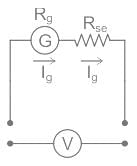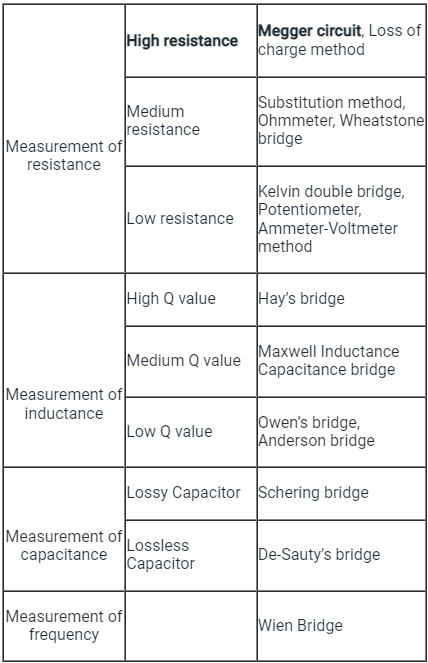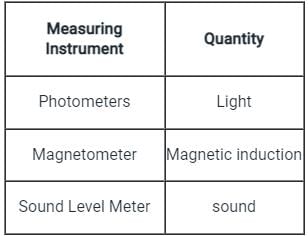All Exams >
Electrical Engineering (EE) >
6 Months Preparation for GATE Electrical >
All Questions
All questions of Measuring Instruments for Electrical Engineering (EE) Exam
More power is required to operate a moving-iron meter than a PMMC meter because of the magnetic circuit's high _____.- a)resistance
- b)reluctance
- c)retentivity
- d)resilience
Correct answer is option 'B'. Can you explain this answer?
More power is required to operate a moving-iron meter than a PMMC meter because of the magnetic circuit's high _____.
a)
resistance
b)
reluctance
c)
retentivity
d)
resilience
|
|
Rhea Reddy answered |
Moving iron meter has large magnetic reluctance as compared to PMMC meter. That’s why more power is required to operate the moving iron meter.
Advantages of moving iron:
- It is a universal instrument which can be used for the measurement of AC and DC quantities
- These instruments can withstand large loads and are not damaged even under severe overload conditions
- It is very cheap due to the simple construction
Disadvantages of moving iron:
- These instruments suffer from error due to hysteresis, frequency change and stray losses
- The reading of the instrument is affected by temperature variation
Note: In terms of accuracy PMMC meter has the highest accuracy. The order of accuracy is given below.
Induction < Moving iron < PMMC instruments
Induction < Moving iron < PMMC instruments
If a power transformer has a star-connected primary and a delta-connected secondary, then the CT connections on its primary and secondary sides should be:- a)Delta and Star respectively
- b)Star and Delta respectively
- c)Delta and Delta respectively
- d)Star and Star respectively
Correct answer is option 'A'. Can you explain this answer?
If a power transformer has a star-connected primary and a delta-connected secondary, then the CT connections on its primary and secondary sides should be:
a)
Delta and Star respectively
b)
Star and Delta respectively
c)
Delta and Delta respectively
d)
Star and Star respectively
|
|
Rhea Reddy answered |
Power transformer
- A power transformer is a static machine used for transforming power from one circuit to another without changing the frequency.
- A power transformer can increase or decrease the voltage and current, hence can be used as either a step-up or step-down transformer.
Current transformer
- A current transformer is a type of transformer that is mainly designed to reduce the high currents to a lower value for measurement and protection purposes.
- Basically, a current transformer is a voltage step-up and current step-down transformer which means when it reduces the current, it increases the voltage in the same ratio.
- A power transformer and a current transformer are always connected in opposite phase connection.
If a power transformer has a star-connected primary and a delta-connected secondary, the CT connections on its primary and secondary sides should be connected in delta and star respectively.
In order to nullify the phase shift of the Power transformer (PT), The Current transformers (CT) are connected in a reverse configuration.


The braking torque of induction type single-phase energy meter is:- a)Directly proportional to the square of the flux
- b)Directly proportional to the flux
- c)Inversely proportional to the flux
- d)Inversely proportional to the square of the flux
Correct answer is option 'A'. Can you explain this answer?
The braking torque of induction type single-phase energy meter is:
a)
Directly proportional to the square of the flux
b)
Directly proportional to the flux
c)
Inversely proportional to the flux
d)
Inversely proportional to the square of the flux
|
|
Rhea Reddy answered |
Energy meter:
Energy meter or Watt-hour meter is used to measure the energy in kWh.
It is an integrating type instrument.
Its working principle is similar to the transformer.
There are three essential mechanisms required in the energy meter named Driving torque, Braking torque, and registered mechanism.
Driving torque:
This torque is required to revolve the disc or rotate the disc.
It is obtained by the electromagnetic induction effect.
Braking torque:
It is required to rotate the disc at a constant speed.
It is obtained by using a permanent magnet placed inside the energy meter near the Aluminum disc.
Eddy currents have induced in the magnet due to the movement of the rotating disc through the magnetic field. This eddy current reacts with the flux and exerts a braking torque which opposes the motion of the disk. The speed of the disk can be controlled by changing flux.
Breaking torque of induction type single-phase energy meter is:


K = constant
ϕ = flux
N = speed in rpm
R = radius of the disc
Re = resistance in path of current (i.e. disc)
The braking torque of induction type single-phase energy meter is directly proportional to the square of the flux.
Registered mechanism:
It registers the no. of rotations or revolutions of the disc which is proportional to the energy consumed in kWh.
Meter constant = (No. of revolutions / kWh)
Points to remember:
Creeping:
Sometimes the disc of the energy meter makes the slow but continuous rotation at no load i.e. when the potential coil is excited but with no current flowing in the load called creeping error
This error may be caused due to overcompensation for friction, excessive supply voltage, vibrations, stray magnetic fields, etc
It can be reduced by making two opposite holes on the disc.
If a 100 watts bulb is used for 10 hours, then the amount of consumed electrical energy will be -- a)100 Watts
- b)100 Watts per hour
- c)1000 Watts (1 KW)
- d)1 KWh (1 unit of electricity)
Correct answer is option 'D'. Can you explain this answer?
If a 100 watts bulb is used for 10 hours, then the amount of consumed electrical energy will be -
a)
100 Watts
b)
100 Watts per hour
c)
1000 Watts (1 KW)
d)
1 KWh (1 unit of electricity)
|
|
Rhea Reddy answered |
The correct answer is 1 KWh.
Concept:
Electric bulb: It is an electric device that converts electric energy into heat and light energy.
- Resistance of the bulb

- If we consider the bulb as a resistor then, we can easily find the current and voltage drops.
- Power consumed = i2R
- Power consumed ∝ Brightness
The rate of work done by the electric current is called as electric power.
The difference of potential between two points is called a potential difference.
- Electric energy (E) = electric power (P) × time (t)
Unit of electric energy = unit of electric power × unit of time = kilowatt × hour = kilowatt-hour
A meter reads 125 V and the true value of the voltage is 125.5 V. Find the static error of the instrument.- a)125/0.5 V
- b)125 V
- c)0.5 V
- d)0.5 / 125 V
Correct answer is option 'C'. Can you explain this answer?
A meter reads 125 V and the true value of the voltage is 125.5 V. Find the static error of the instrument.
a)
125/0.5 V
b)
125 V
c)
0.5 V
d)
0.5 / 125 V
|
|
Rhea Reddy answered |
Concept:
Absolute Error: The deviation of the measured value from the true value (or) actual value is called error. It is also known as a static error.
Static error (E) = Am – At
Am = Measured value
At = True value
Relative Static Error: The ratio of absolute error to the true value is called relative static error.

Limiting Error:
The maximum allowable error in the measurement is specified in terms of true value, is known as limiting error. It will give a range of errors. It is always with respect to true value, so it is a variable error.
Guaranteed Accuracy Error:
The allowable error in measurement is specified in terms of full-scale value is known as a guaranteed accuracy error. It is a variable error seen by the instrument since it is with respect to full-scale value.
Application:
Given-
Am = 125 V, At = 125.5 V
∴ Static error (E) = 125 - 125.5
E = 0.5 V
When the pointer of an indicating instrument is in motion, then the deflecting torque is opposed by:- a)Damping torque
- b)Controlling torque
- c)Both damping torque and controlling torque
- d)Rotating torque
Correct answer is option 'B'. Can you explain this answer?
When the pointer of an indicating instrument is in motion, then the deflecting torque is opposed by:
a)
Damping torque
b)
Controlling torque
c)
Both damping torque and controlling torque
d)
Rotating torque
|
|
Rhea Reddy answered |
The essential features are possessed by an indicating instrument deflecting, controlling, and a damping device.
- Deflecting device: The deflection device produces deflecting torque which causes the moving system to move from its zero position.
- Controlling device: The controlling device produces the controlling torque (Tc) which opposes the deflecting torque and increases with the deflection of the moving system. It also brings the pointer back to zero when the deflecting torque is removed.
- Damping device: This device produces damping torque this torque is necessary to bring the pointer to rest quickly. This damping torque (Td) is used to reduce the oscillation.
A galvanometer may be converted into ammeter or voltmeter. In which of the following cases the resistance of the device will be the largest?- a)an ammeter of range 10 A
- b)a voltmeter of range 5 volt
- c)an ammeter of range 5 A
- d)a voltmeter of range 10 V
Correct answer is option 'D'. Can you explain this answer?
A galvanometer may be converted into ammeter or voltmeter. In which of the following cases the resistance of the device will be the largest?
a)
an ammeter of range 10 A
b)
a voltmeter of range 5 volt
c)
an ammeter of range 5 A
d)
a voltmeter of range 10 V
|
|
Rhea Reddy answered |
Concept:
A galvanometer can be converted into an ammeter by connecting a low resistance in parallel.


The effective resistance of device = Rsh in parallel with Rg
Where Rg is galvanometer resistance
A galvanometer can be converted into a voltmeter by connecting a high resistance in series.

The effective resistance of device = Rse in series with Rg
Where Rg is galvanometer resistance
Application:
The voltmeter has high resistance and ammeter has low resistance.
Voltmeter with high full-scale range has high resistance.
So, a voltmeter of range 10 V has higher resistance.
The megohmmeter is used for the measurement of:- a)High value capacitance
- b)Medium value resistance
- c)High value resistance
- d)Low value resistance
Correct answer is option 'C'. Can you explain this answer?
The megohmmeter is used for the measurement of:
a)
High value capacitance
b)
Medium value resistance
c)
High value resistance
d)
Low value resistance
|
|
Rhea Reddy answered |
A megohmmeter is an electric meter that measures very high resistance values by sending a high-voltage signal into the object being tested.
Measurement of resistance, inductance, and capacitance


A galvanometer is used to ________.- a)detect the direction of light
- b)detect the direction of current
- c)detect the direction of magnetic induction
- d)detect the direction of sound
Correct answer is option 'B'. Can you explain this answer?
A galvanometer is used to ________.
a)
detect the direction of light
b)
detect the direction of current
c)
detect the direction of magnetic induction
d)
detect the direction of sound
|
|
Rhea Reddy answered |
A Galvanometer is used to detect the direction of the current.
This device is used for detecting and measuring a small amount of electric current.
Johann Schweigger invented the device in 1820.

This device is used for detecting and measuring a small amount of electric current.
Johann Schweigger invented the device in 1820.

The difference between the indicated value and the true value of a quantity is:- a)Gross error
- b)Absolute error
- c)Dynamic error
- d)Relative error
Correct answer is option 'B'. Can you explain this answer?
The difference between the indicated value and the true value of a quantity is:
a)
Gross error
b)
Absolute error
c)
Dynamic error
d)
Relative error
|
|
Rhea Reddy answered |
Absolute error (ε):
The difference between the indicated or measured value and the true or actual value is called absolute error. Also known as a static error.
Absolute error (ε) = Am - At
Where
Am = measured or indicated value
At = true or actual value
Gross error:
Absolute error (ε) = Am - At
Where
Am = measured or indicated value
At = true or actual value
Gross error:
- Gross errors are the observational errors that happen due to the lack of observation of the observer.
- These errors vary from observer to observer.
- The gross errors may also occur due to improper selection of the instrument.
Relative error:
The relative error is the absolute error over the true or actual value.
Relative static error R.S.E = ε / At = 

% R.S.E =  × 100
× 100
 × 100
× 100Probable error is a quantity formerly used as a measure of variability which is equal to 0.6745 times the standard deviation.
Chapter doubts & questions for Measuring Instruments - 6 Months Preparation for GATE Electrical 2025 is part of Electrical Engineering (EE) exam preparation. The chapters have been prepared according to the Electrical Engineering (EE) exam syllabus. The Chapter doubts & questions, notes, tests & MCQs are made for Electrical Engineering (EE) 2025 Exam. Find important definitions, questions, notes, meanings, examples, exercises, MCQs and online tests here.
Chapter doubts & questions of Measuring Instruments - 6 Months Preparation for GATE Electrical in English & Hindi are available as part of Electrical Engineering (EE) exam.
Download more important topics, notes, lectures and mock test series for Electrical Engineering (EE) Exam by signing up for free.
6 Months Preparation for GATE Electrical
675 videos|1297 docs|786 tests
|

Contact Support
Our team is online on weekdays between 10 AM - 7 PM
Typical reply within 3 hours
|
Free Exam Preparation
at your Fingertips!
Access Free Study Material - Test Series, Structured Courses, Free Videos & Study Notes and Prepare for Your Exam With Ease

 Join the 10M+ students on EduRev
Join the 10M+ students on EduRev
|

|
Create your account for free
OR
Forgot Password
OR
Signup on EduRev and stay on top of your study goals
10M+ students crushing their study goals daily









